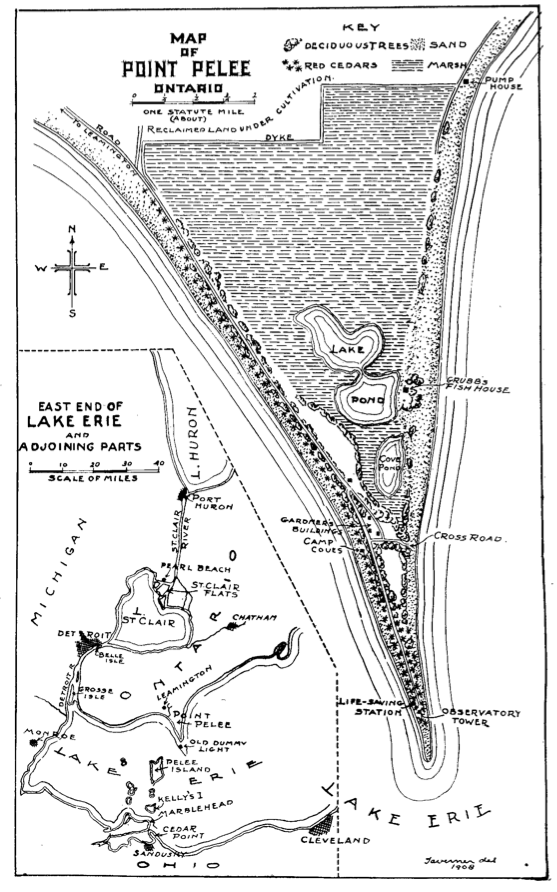One of the pictures on the poster I displayed at the AOS booth at the conference last week showed 5 men who called themselves the Great Lakes Ornithological Club.

The GLOC began in the early 1900s when a group of six friends—from Ontario and Michigan—who were interested in birds decided that they would benefit from occasional meetings where they could watch birds and exchange ideas. The photo above includes five of them, from left to right: James S. Wallace, Bradshaw H. Swales, William E. Saunders, James H. Fleming and Percy A. Taverner (seated front right). Maybe the sixth man, A. Brooker Klugh, took the picture. Taverner and Swales lived in Detroit, Michigan at the time and the others were from Guelph, Kingston, London and Toronto, Ontario. In 1905, they built the small cabin shown in the photo at Point Pelee and that became their clubhouse. Their club never took on any new members and finally disbanded in 1927 shortly after Wallace died.
Early on they decided they needed a ‘journal’ to keep track of and disseminate their ideas and so established a ‘bulletin’ to circulate among the members. As described by Fleming (1939):
The procedure was simple—any member with an idea relating to birds wrote it out on a sheet of eight by ten inch paper, and posted it to the secretary in an especially printed envelope marked “Printer’s Mss.” The secretary, if so inclined, added comments on a separate sheet of paper and forwarded the bulletin to the next member and so on in rotation, till it reached the original sender who removed his contribution and forwarded the remaining manuscript to the secretary who also removed his from the file and added any new matter that had come to hand with his comments but always on a fresh sheet of paper, thus the bulletin passed in rotation to the six members but never grew too bulky.
Little did they know they were anticipating the modern blog post (with comments). Their little bulletin was especially active from 1905-1909 and provided a means for the club to discuss issues of “migration routes, injurious species, the mild winter of 1905-6, and even subspecies” (Fleming 1939: 42).
Four of these men are well enough known that I will devote later blog posts to each of them. Taverner was the only one to become a professional ornithologist being appointed to the National Museum of Canada (Ottawa) in 1912, a position he held until he retired in 1942. He was actually trained and first employed as an architect in Chicago, Detroit and Ottawa but I have no doubt that the GLOC was the genesis of his career in ornithology.

The GLOC also had a hand in the establishment of Point Pelee National Park—one of the world’s great birding sites—in 1918, and in the Migratory Birds Convention Act in 1916, but those, too, are stories for another day. Although they were all, at least at the start, amateur ornithologists, the GLOC had some influence on early 20th century American ornithology, publishing more than 400 papers in The Auk, The Condor and other journals in their lifetimes and making substantial contributions of specimens, libraries, and time to the National Museum of Canada, the US National Museum, and the Royal Ontario Museum. Fleming (1939) felt that the GLOC’s main contributions were to better understand migration routes and the annual cycles of birds, two topics that are still of great interest if the myriad excellent papers at last week’s AOS conference are any indication (and they are!).
I think that the GLOC may have been one of very few local bird clubs that drew members from two different countries, showing early on that science and ornithology seamlessly transcend political boundaries, like the AOS of today. There must have been thousands of these little bird clubs in the history of ornithology worldwide, each with its own story and contribution to the growth and development of bird study. If you know of one that you would like me to write about (or would like to contribute a post about) let me know in the comments.
If you are interested, you can read more about the GLOC in Fleming (1939) and Taverner and Swales (1907).
REFERENCES
Fleming JH (1939) The Great Lakes Ornithological Club. The Wilson Bulletin 51:42-43
Taverner PA (1934) Birds of Canada. National Museum of Canada, Ottawa.
Taverner PA, Swales BH (1907) The birds of Point Pelee. The Wilson Bulletin 19:37-54
IMAGES: Photo of GLOC: photographer unknown. Original photograph from James L. Baillie, now in the collection of James Richards of Orono, Ontario. Used with permission. Map: from Taverner and Swales (1907)